You'll love this delightful vanilla rooibos tea cake frosting recipe. Start by brewing a strong rooibos tea infusion, then create a classic buttercream base with softened butter and powdered sugar. Incorporate the cooled tea and vanilla extract for a unique flavor profile. Adjust the consistency with cream or milk as needed. Confirm all ingredients are at room temperature and sift the sugar for a smooth texture. Decorate your cake with piping techniques or create a rustic naked cake look. Add visual interest with edible flowers or a dusting of rooibos tea leaves. The possibilities for customization are endless with this versatile frosting.
Ingredients for Rooibos Tea Frosting
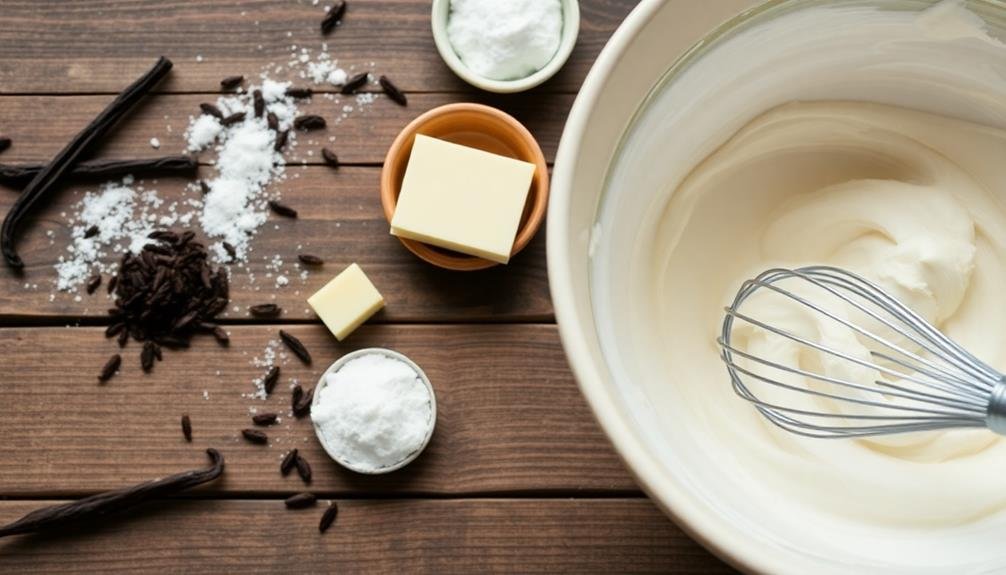
Simplicity is key when it comes to the ingredients for this delightful Rooibos Tea Frosting.
You'll need just a few high-quality components to create a smooth, flavorful topping for your cake. Start with 1 cup of unsalted butter, softened to room temperature. This will form the base of your frosting, providing a rich, creamy texture.
Next, you'll need 3 cups of powdered sugar to sweeten the mixture and give it structure. For the unique flavor profile, steep 2 Rooibos tea bags in 2 tablespoons of hot water for 5 minutes, then let it cool. This concentrated tea infusion will impart a subtle, earthy taste to your frosting.
Add 1 teaspoon of vanilla extract to enhance the overall flavor and complement the Rooibos. You'll also need a pinch of salt to balance the sweetness.
For a smoother consistency, include 2 tablespoons of heavy cream or milk.
These simple ingredients combine to create a frosting that's not only delicious but also showcases the unique flavor of Rooibos tea.
Be sure to use fresh, high-quality ingredients for the best results in your Vanilla Rooibos Tea Cake Frosting.
Brewing the Perfect Rooibos Infusion
For the perfect Rooibos infusion, start with high-quality loose-leaf Rooibos tea. You'll need about 1 tablespoon of tea leaves for every 8 ounces of water.
Heat your water to just below boiling, around 200°F (93°C). Rooibos is forgiving, so don't worry if you don't have a thermometer; just let the water cool for a minute after boiling.
Place the tea leaves in a tea infuser or directly in your teapot. Pour the hot water over the leaves and let it steep for 5-7 minutes.
Unlike black or green tea, Rooibos won't become bitter with extended steeping, so you can adjust the time to your taste preference.
After steeping, strain the tea if necessary and let it cool completely before using it in your frosting recipe.
For a stronger flavor, you can increase the amount of tea leaves or steeping time. To enhance the vanilla notes in your frosting, consider adding a vanilla bean to the infusion while it steeps.
Preparing the Frosting Base
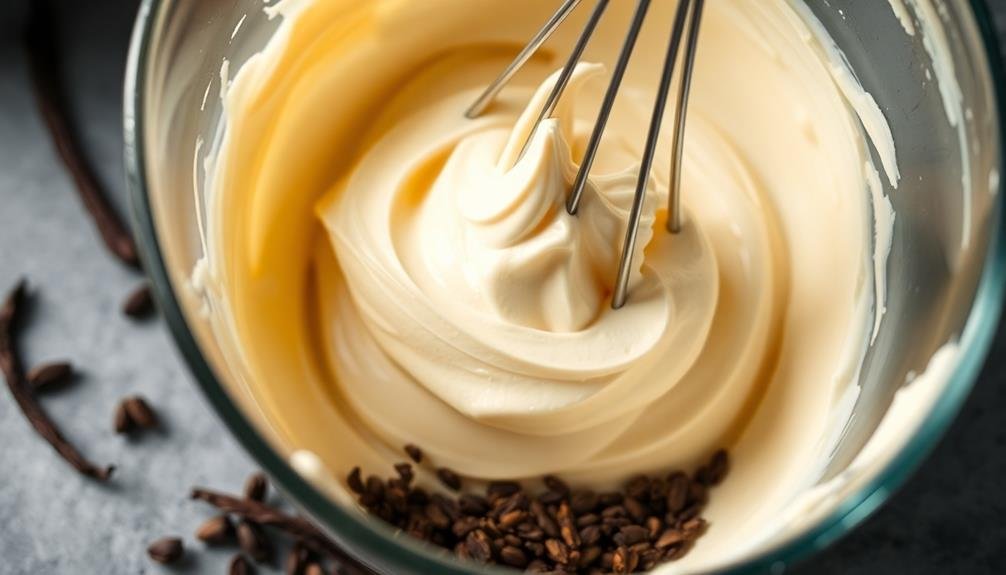
The foundation of your Vanilla Rooibos Tea Cake Frosting begins with a classic buttercream base. You'll need unsalted butter, powdered sugar, vanilla extract, and a pinch of salt.
Start by softening the butter to room temperature, which guarantees a smooth, creamy texture. In a large mixing bowl, cream the butter until it's light and fluffy, using an electric mixer on medium speed for about 3-5 minutes.
Next, gradually add the powdered sugar, mixing on low speed to avoid a sugar cloud. Once it's incorporated, increase the speed and beat for another 2-3 minutes until the mixture is pale and creamy.
Add the vanilla extract and salt, then mix until combined.
Now, you'll want to adjust the consistency. If it's too thick, add a tablespoon of milk or cream. If it's too thin, incorporate more powdered sugar. The ideal texture should be spreadable but firm enough to hold its shape.
This base provides the perfect canvas for introducing the rooibos flavor in the next step, assuring your frosting will have the right balance of sweetness and tea essence.
Incorporating Rooibos Tea Flavor
To infuse your frosting with robust rooibos flavor, you'll want to start by steeping the tea for an extended period.
Once you've extracted maximum flavor, reduce the tea to create a concentrated syrup.
You'll then need to carefully balance the tea concentrate with vanilla extract to achieve the perfect harmony of flavors in your frosting.
Steeping for Maximum Flavor
Steeping is the key to releasing rooibos tea's full flavor potential in your cake frosting. To achieve the best results, start by heating water to just below boiling point, around 200°F (93°C). Use 1 tablespoon of loose rooibos tea or 1 tea bag per cup of water. Pour the hot water over the tea and let it steep for 5-7 minutes. This longer steeping time allows the tea's natural sweetness and complexity to develop fully.
For a more intense flavor, you can increase the steeping time to 10 minutes, but be cautious as over-steeping may lead to bitterness. After steeping, strain the tea and let it cool to room temperature before incorporating it into your frosting recipe.
To maximize flavor extraction, gently press the tea leaves or bag against the strainer to release any remaining liquid.
Consider making a concentrated tea infusion by doubling the amount of tea used while keeping the water volume the same. This will create a stronger flavor base for your frosting without adding excess liquid.
Remember to adjust your recipe accordingly when using a concentrated infusion to maintain the desired consistency.
Reducing Tea Concentrate
Once you've steeped your rooibos tea, it's time to intensify its flavor for your frosting. Pour the steeped tea into a small saucepan and place it over medium heat.
You'll want to reduce the liquid by about half, which will concentrate the tea's flavors. Keep a close eye on the pan, stirring occasionally to prevent any burning or sticking.
As the tea simmers, you'll notice the color deepening and the aroma becoming more pronounced. This process typically takes about 10-15 minutes, depending on your starting volume.
You're aiming for a syrupy consistency that coats the back of a spoon. Once you've achieved this, remove the pan from heat and let the concentrate cool completely.
Strain the cooled concentrate through a fine-mesh sieve to remove any tea particles. This step guarantees a smooth texture in your final frosting.
You can now refrigerate the concentrate until you're ready to use it. When incorporating it into your frosting, start with small amounts and taste as you go.
The concentrated flavor allows you to add robust tea notes without thinning your frosting's consistency.
Balancing Tea and Vanilla
With your rooibos tea concentrate ready, it's time to balance its unique flavor with vanilla in your frosting. Rooibos tea has a distinct earthy, nutty taste with subtle notes of caramel and honey. To complement these flavors, you'll want to use a high-quality vanilla extract or vanilla bean paste.
Start by adding a small amount of vanilla to your frosting base, then gradually incorporate the rooibos concentrate. Taste as you go, adjusting the ratios until you achieve the perfect balance. Remember, the tea flavor should be noticeable but not overpowering. If you find the tea taste too strong, add more vanilla or a touch of honey to soften it.
For a more complex flavor profile, consider using both vanilla extract and vanilla bean seeds. The extract provides a smooth, consistent vanilla flavor, while the seeds add visual appeal and bursts of intense vanilla taste.
As you mix, pay attention to the frosting's texture. If it becomes too thin from the tea concentrate, add more powdered sugar to maintain the desired consistency. The goal is to create a frosting that showcases both the rooibos tea and vanilla flavors harmoniously.
Texture and Consistency Tips
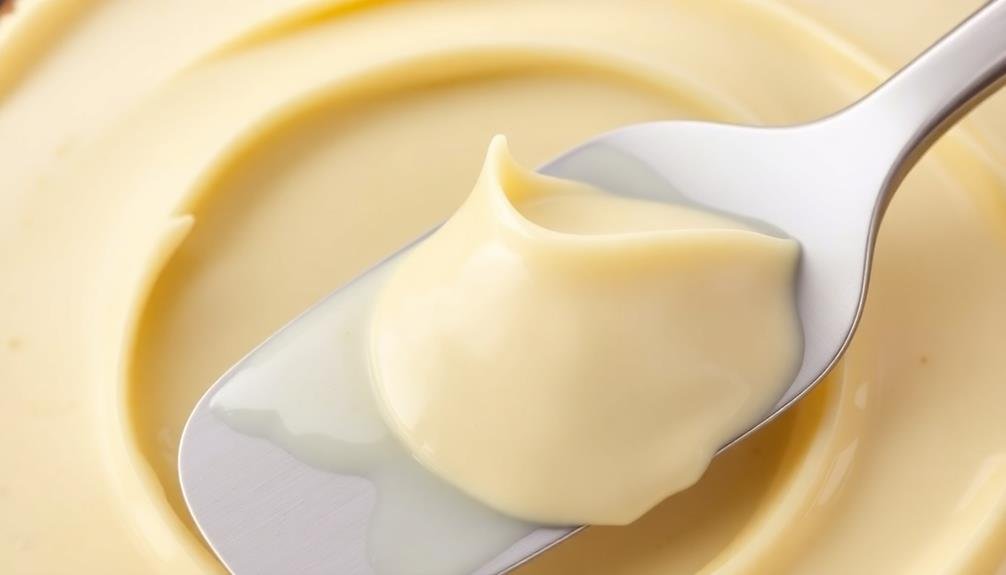
You'll want to focus on achieving a smooth, creamy texture for your vanilla rooibos tea cake frosting.
To prevent lumps, make sure your butter is at room temperature and sift your powdered sugar before mixing.
Beat the frosting thoroughly and add liquid gradually to avoid separation, ensuring a perfectly spreadable consistency.
Achieving Smooth, Creamy Texture
To achieve a smooth and creamy texture in your vanilla rooibos tea cake frosting, pay close attention to the consistency as you mix. Start with room temperature butter and cream cheese, as they'll blend more easily. Cream these ingredients together until light and fluffy, scraping down the sides of the bowl frequently.
Gradually add powdered sugar, sifting it first to remove any lumps. This step is essential for a silky texture. Incorporate the sugar in small batches, mixing thoroughly between additions. If you're using liquid flavorings like vanilla extract or brewed rooibos tea, add them slowly to prevent the mixture from separating.
For extra smoothness, consider using a stand mixer with a paddle attachment. This will incorporate air into the frosting, making it lighter and creamier. If you notice any graininess, continue beating on medium-high speed for a few more minutes.
Don't overmix, as this can lead to a runny consistency. If your frosting becomes too thin, refrigerate it for 15-20 minutes before continuing. Conversely, if it's too thick, add a teaspoon of milk or cream at a time until you reach the desired consistency.
Preventing Lumps and Separation
Lumps and separation can quickly ruin the smooth texture of your vanilla rooibos tea cake frosting. To prevent these issues, you'll need to take a few precautions during preparation.
First, verify all your ingredients are at room temperature before mixing. Cold butter or cream cheese can create lumps that are difficult to smooth out.
Sift your powdered sugar before adding it to the mixture. This step removes any clumps and helps the sugar incorporate more evenly.
When adding liquid ingredients like vanilla extract or brewed rooibos tea, do so gradually while continuously mixing. This prevents the frosting from becoming too thin or separating.
If you notice lumps forming, stop mixing immediately. Overmixing can cause the frosting to separate or become grainy. Instead, gently press the lumps against the side of the bowl with a spatula to break them up.
For stubborn lumps, try passing the frosting through a fine-mesh sieve.
If your frosting does separate, don't panic. You can often rescue it by refrigerating for 15-20 minutes, then re-whipping it slowly. This allows the ingredients to re-emulsify, restoring the smooth, creamy texture you're aiming for.
Decorating With Rooibos Tea Frosting
Decorating with rooibos tea frosting opens up a world of creative possibilities for your cake. You'll find that this unique frosting's subtle earthy flavor and warm reddish-brown hue complement a variety of cake designs.
To start, you can use a piping bag with different tips to create intricate patterns, rosettes, or borders. The frosting's consistency allows for smooth, even coverage when spread with a spatula, making it ideal for creating a rustic naked cake look.
For a more elegant touch, try using the frosting to create ombré effects by gradually lightening or darkening the color as you move up the cake. You can also incorporate edible flowers or herbs that pair well with rooibos tea, such as lavender or mint, to enhance both the visual appeal and flavor profile.
Don't forget about texture – use a fork or comb to create interesting patterns on the frosting's surface. For a finishing touch, dust the cake with finely ground rooibos tea leaves or sprinkle with tea-infused sugar for a subtle shimmer.
Frequently Asked Questions
Can I Use Decaffeinated Rooibos Tea for This Frosting Recipe?
Yes, you can definitely use decaffeinated rooibos tea for this frosting recipe. It won't affect the flavor or texture of your frosting. You'll still get the same delicious taste without the caffeine. It's a great option for those avoiding caffeine.
How Long Does the Rooibos Tea Frosting Stay Fresh?
You'll find your rooibos tea frosting stays fresh for about 3-5 days when refrigerated. It's best to use it within this time frame for ideal taste and texture. Don't forget to store it in an airtight container!
Is It Possible to Make This Frosting Vegan-Friendly?
Yes, you can make this frosting vegan-friendly. You'll need to substitute dairy butter with vegan butter and use plant-based milk instead of regular milk. Coconut cream can replace heavy cream if needed. These swaps won't compromise the flavor.
Can I Add Food Coloring to the Rooibos Tea Frosting?
Yes, you can add food coloring to your rooibos tea frosting. You'll find that gel or paste colors work best, as they won't thin out the frosting. Start with a small amount and gradually increase until you've achieved your desired shade.
What Cake Flavors Pair Best With Rooibos Tea Frosting?
You'll find that rooibos tea frosting pairs beautifully with vanilla, almond, or lemon cakes. It also complements spice cakes, carrot cake, or even chocolate. Don't be afraid to experiment with different flavors to find your favorite combination!
In Summary
You've now mastered the art of creating a delicious vanilla rooibos tea cake frosting. With its unique flavor and creamy texture, you'll impress your guests at any gathering. Don't be afraid to experiment with different rooibos blends or decorating techniques to make it your own. Remember, the key is in the tea infusion and achieving the right consistency. Your cakes will never be the same once you've tried this exceptional frosting. Enjoy your sweet creation!

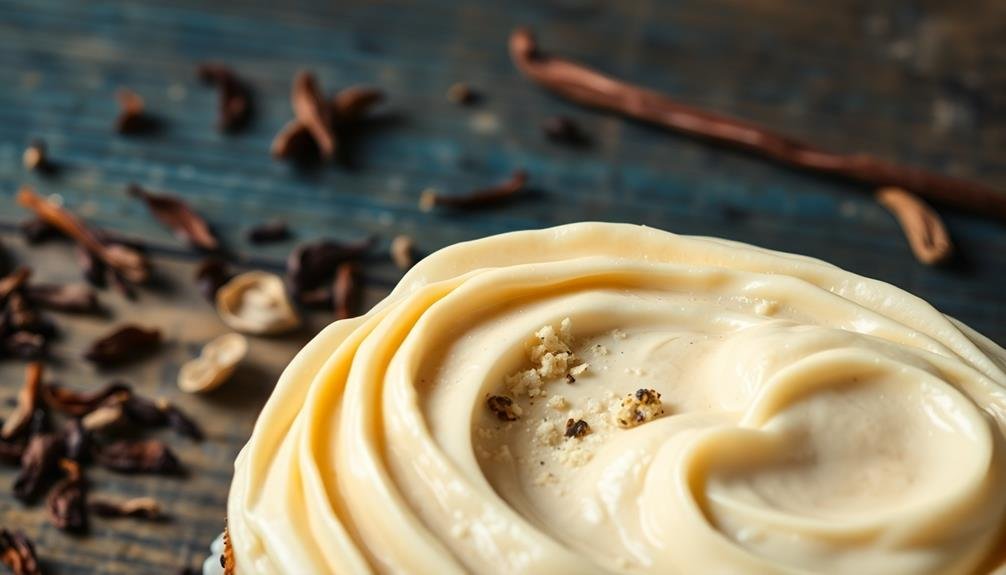
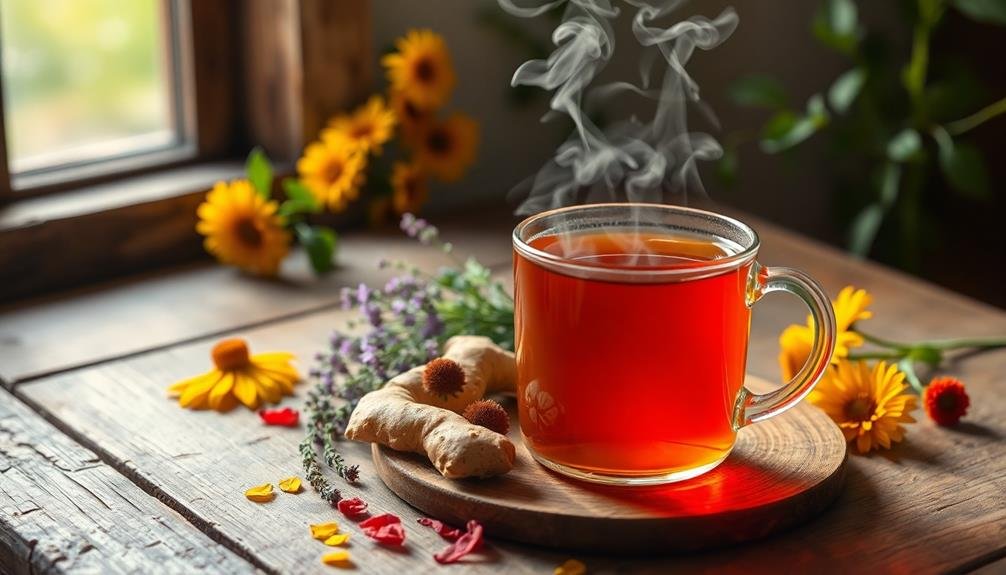
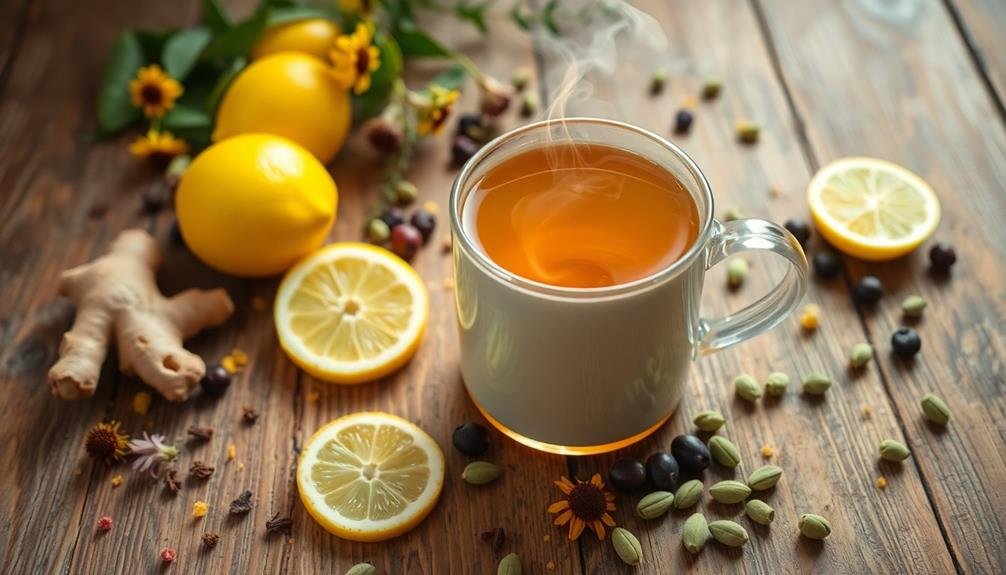
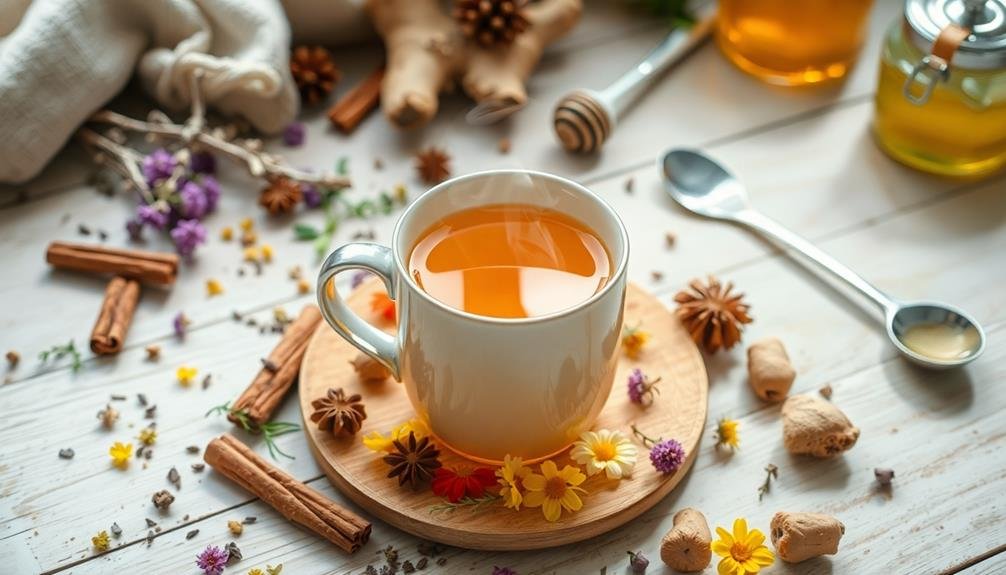
Leave a Reply